 An impressive ten teams competed in last May’s inaugural USEA Intercollegiate Eventing Team Championship. | © Leslie Threlkeld
An impressive ten teams competed in last May’s inaugural USEA Intercollegiate Eventing Team Championship. | © Leslie ThrelkeldContinuing their sport in college has been relatively easy for hunt seat, dressage and Western riders for many years. Close to 400 colleges offer Intercollegiate Horse Shows Association teams, 42 colleges and universities participate in the Interscholastic Dressage Association and 21 institutions have athletic-department-funded varsity hunt seat and/or Western teams. All together, there are plentiful opportunities for riders in those disciplines. Eventers, not so much.
Clemson University in South Carolina, Otterbein University in Ohio and the University of California Davis are among a handful of schools that have had eventing teams for many years. Yet, with the exception of the mid-Atlantic and Southeast, squads in most of the country have had few, if any, teams to square off against.
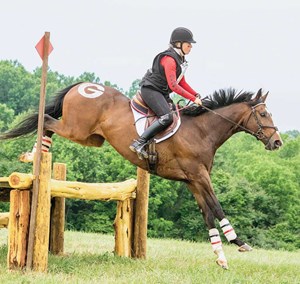 University of Georgia student Devon Olivier, riding Karisma, was part of the first-placed team at the championship, which was held during the Virginia Horse Trials. | © Shelby Allen/USEA
University of Georgia student Devon Olivier, riding Karisma, was part of the first-placed team at the championship, which was held during the Virginia Horse Trials. | © Shelby Allen/USEAHappily, that’s changing. In 2014, the U.S. Eventing Association launched the Intercollegiate Eventing Program. In its first full year, the IEP had 21 schools involved and it now counts approximately 40. USEA CEO Rob Burk is an Otterbein graduate himself and had long believed eventers deserved a way to continue the sport through college and to represent their schools doing so.
The team appeal is strong. As University of Georgia captain Emily Cox says, “Growing up riding, the thing I didn’t like about it was that it was not a team sport like my brother had as a soccer player. When I heard about Georgia having an eventing team, I wanted to be part of that.” She was an important part of the team at the inaugural USEA Intercollegiate Eventing Team Championship last May, riding FR’s Check It Out, as one of three Training-level Bulldogs contributing to UGA’s razor-thin win over Clemson.
From a sport growth perspective, Rob sees collegiate eventing as a great way to maintain or increase membership in the 18-to-24-year-old demographic that historically dips during college years. Even as an eventer, he recalls letting his membership lapse during college. Today USEA membership reflects new increases in that age group.
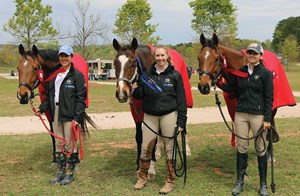 UGA riders took part in an Intercollegiate Team Challenge last April at the Chatt Hills Horse Trials: (pictured from left) Ava Mohiuddin, Devon Olivier and Emily Cox. | Courtesy, Emily Cox
UGA riders took part in an Intercollegiate Team Challenge last April at the Chatt Hills Horse Trials: (pictured from left) Ava Mohiuddin, Devon Olivier and Emily Cox. | Courtesy, Emily CoxThe IEP’s formation builds on grass-roots efforts that have been under way for awhile. Around 2011, members of the University of California Davis Event Team created the West Coast Collegiate Eventing League. Four schools took part in the first competition held in conjunction with the Twin Rivers Horse Trials in Paso Robles. A few years later, UC Davis rider Amelia Clyatt connected with Leigh Casaceli of the Clemson Eventing Team to create the Intercollegiate Eventing League. Using the USEA’s Adult Team Challenges as a model, they developed the Intercollegiate Team Challenge concept and pursued it with a receptive USEA. In 2013, USEA’s then-President Brian Sabo created a task force to further collegiate eventing and, in 2014, the Intercollegiate Event Program was born. Rob’s ascension to USEA CEO soon after guaranteed it would stay a top priority.
The Intercollegiate Eventing Program provides a framework on which eventing teams and individual competition can flourish at universities and colleges across the country. It offers affiliate membership to college and university eventing teams and discounted individual USEA membership to students who belong to those teams.
The jump in affiliate schools in two years and the success of the inaugural USEA Intercollegiate Eventing Team Championship bode well for the future. Staged as part of the Virginia Horse Trials, the championship drew 10 teams and helped to put the newly formalized endeavor on the national map.
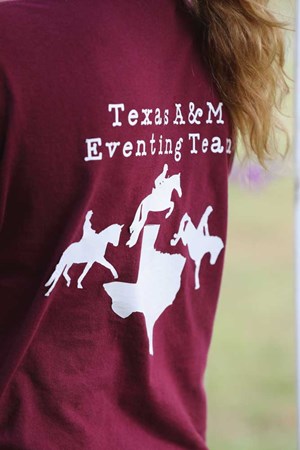 A Texas A&M student proudly represents her college’s eventing team. | © Manuel Flores
A Texas A&M student proudly represents her college’s eventing team. | © Manuel FloresLike the champions University of Georgia Bulldogs, most of those 10 teams hailed from the mid-Atlantic and Southeast (USEA Areas II and III), where eventing’s popularity and density of competitions make it fertile ground for collegiate competitions. But those regions may not corner the market for long. Texas A&M’s brand-new, 31-member team is targeting the 1,400-mile trek to the championship, again set for the Virginia Horse Trials in 2017, with at least one team, maybe two, says founder, Aggie senior Kate Boggan.
How Teams Work
The IEP does not dictate how or by whom affiliate teams are organized or run, and details vary. Horse ownership is generally a requirement that separates collegiate eventing teams from those for the other disciplines. In school-to-school competitions, hunt seat, dressage and Western squads catch-ride horses provided by the host school. The rigors and risks of the cross-country phase make catch-riding unrealistic for collegiate eventing. Some teams have opportunities to lease a horse for the season and several offer memberships to those who don’t ride but want to help and enjoy the social connections that come from shared enthusiasms.
At schools with strong equine academic programs, like Otterbein and UC Davis, team members often board and ride their horses at the school’s barn. In Otterbein’s case, that is a state-of-the-art equestrian center that includes a cross-country schooling field with a water obstacle and bank jumps.
Texas A&M also has a state-of-the-art equestrian center, but that is reserved for the use of the school’s rodeo, stock-horse, polo and National Collegiate Equestrian Association hunt seat and Western teams. “I do get some disappointed calls from parents when they find out that their students can’t ride there as members of the eventing club team,” notes Kate Boggan. Instead, the 18 “competition-ready” riders keep their horses at private stables in the College Station area, many of them at coach Amanda Merritt’s stable, Anchor Equestrian. The trainer offers a generous discount on boarding and training but team members are not obligated to do either with her program.
 Charlotte Pruet has been a part of Transylvania University’s eventing team since its inception. Now a senior, she competed in the championship aboard her horse Valadour. | © Brant Gamma
Charlotte Pruet has been a part of Transylvania University’s eventing team since its inception. Now a senior, she competed in the championship aboard her horse Valadour. | © Brant GammaMost teams require that members who plan to compete take regular lessons with the team coach or another professional.
The cost of eventing-team membership is another variable. Except for nonriding members, it starts with maintaining one’s own or a leased horse, so it’s more expensive than its hunt seat and dressage counterparts. Membership typically involves fundraising toward the cost of traveling to competitions and entry fees and/or to help reduce expenses for all members. Several Area II teams receive entry and stabling discounts from organizers.
Annual dues at Otterbein are $100 and the administration’s support defrays many expenses. Horse transportation, for example, is usually handled by the school’s truck and trailer, at-home lessons are administered as classes through the school’s academic registrar and coaching at events is handled by Kari Briggs, business manager of the Equestrian Center, all at no extra charge for team members. Riders also have access to coaching from Canadian Olympic eventer Bruce Mandeville, a member of the equine department’s teaching faculty.
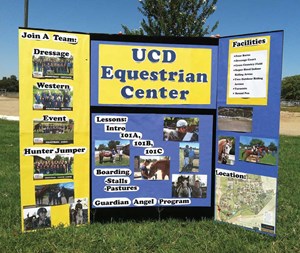 Many colleges with a strong equine academic program, like UC Davis, offer several different discipline options for potential team riders to choose from. | Courtesy, Holly Fox
Many colleges with a strong equine academic program, like UC Davis, offer several different discipline options for potential team riders to choose from. | Courtesy, Holly FoxAt the University of Georgia, membership is $250 per semester, which covers team gear and riding in their derby (a three-phase event designed to help students prepare for the Intercollegiate Team Challenges) and clinics, which this fall included a session with British Olympic gold medalist Leslie Law. Nonrider memberships are $50 per semester. Discounts from competition organizers and equine companies help make it “extremely affordable” to keep eventing through college, says team captain Emily Cox, a senior.
Although only in its fourth year, the UGA team has 30 members and was able to field two squads for the championship. Their team includes five noncompetitors who help with grooming, course walking and other tasks, a natural fit with eventing’s cooperative spirit.
Dedication is another requirement and typically one that’s not hard to find among young eventers, says Tanya Davis, coach of the Transylvania College eventing team in Lexington, Kentucky. Although the designation as a “club” versus “varsity” sport connotes a casual commitment at some schools, that’s not the case with an eventing team.
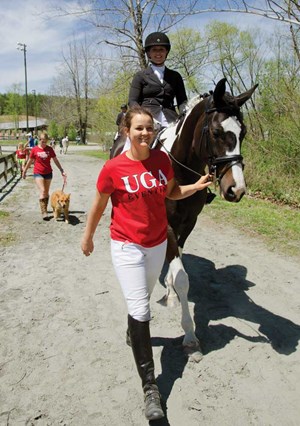 As in other college riding programs, teamwork at the shows is a big part of the overall IEP experience. University of Georgia rider Jorja Miller offers support for her fellow teammate Kelsey Stark at an Intercollegiate Challenge. | © Leslie Threlkeld
As in other college riding programs, teamwork at the shows is a big part of the overall IEP experience. University of Georgia rider Jorja Miller offers support for her fellow teammate Kelsey Stark at an Intercollegiate Challenge. | © Leslie Threlkeld“It’s not like joining a sorority,” says Tanya, owner of Three Day Farm in Lexington. “You have to really be doing this sport to be part of the team.” Originally, the small liberal arts school had an equestrian program with both hunt seat and eventing teams. In 2016, the school switched to having an eventing squad only and to taking it very seriously, making it an administration-supported varsity sport. “Transy” is a National Collegiate Athletic Association Division III school, meaning it cannot give athletic scholarships to an athlete in any sport, but it can give academic scholarships. Tanya has access to about six $1,000 scholarships to use in her recruiting efforts each year and it’s been a big help.
The Transy administration sees a strong connection between eventing riders’ dedication to their sport and their dedication to academics. “These are kids that do things on their own, and that’s what the school really likes,” Tanya says. “They see how it translates to their studies.”
Competing
Now and into the foreseeable future, collegiate eventing competitions will be staged concurrently with a regular horse trials. Team members ride in whichever division suits their ability, typically Beginner Novice to Intermediate. Individual scores are multiplied by a coefficient (i.e.: BN = 1.1; Intermediate = 0.75) to arrive at a team total. A handful of event organizers around the country have agreed to stage USEA Intercollegiate Team Challenges. In 2016, there were 10 on the calendar, concentrated in the mid-Atlantic (Area II) and the South (Area III), but also including the Pine Hill Horse Trials in Area V’s Bellville, Texas.
Rob Burk describes the Challenges as relatively easy for organizers to add to their events. It requires an extra set of ribbons and trophies and the tabulation of team points, which team riders are typically happy to do. In the future, he hopes there will be enough participation to support regional collegiate championships that qualify teams for the national championship, but that’s a ways off.
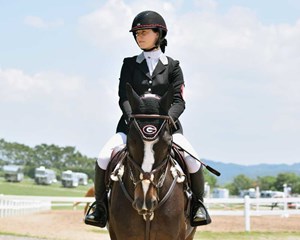 Schwalbestrum sports his team’s logo on his ear net at the championship last May. He and his University of Georgia rider, Emily Cardin, helped lead their team to victory. | © Shelby Allen/USEA
Schwalbestrum sports his team’s logo on his ear net at the championship last May. He and his University of Georgia rider, Emily Cardin, helped lead their team to victory. | © Shelby Allen/USEAIn some areas, schools take pride in competing even when they don’t have schools to ride against. University of California Davis coach Holly Fox is a collegiate eventing pioneer, having organized a team since the mid-1980s. Until recently, that’s mostly meant going solo. “We would go to different competitions like Ram Tap [in Fresno, California, now known as the Fresno County Horse Park] and Woodside Horse Park and be the solo collegiate eventing team,” she explains. “We did it for the passion and the love of the sport.”
Around 2010, riders at other schools became interested and organizers were happy to “set out a table at the competitions where anyone who attended a college or junior college could put together a scratch team.” State schools including Chico, Sonoma and Fresno were among those represented by riders even though they didn’t have formal teams.
Holly is thrilled that the USEA has become involved. The national backing is particularly helpful with the continuity issues that can plague student-run organizations as leaders graduate and move on.
Holly has been involved from the get-go and is serving on the USEA Collegiate Eventing Task Force. Most often, she finds interested West Coast student eventers need help figuring out how to start a team at their schools. “They don’t know how to approach their school’s administration, which can be scary for a person who hasn’t done it before.” So far, she’s aware of student interest at Cal Poly San Luis Obispo, Chico State and the University of California Santa Cruz. “There’s a little bit of interest there and we hope we can build on that.”
Holly is big on promoting collegiate equestrian to parents. “They are so worried about their kids not being able to make that balance,” she notes. “But the college-educated rider is very good with time management. For riders on all of our teams, we are respectful of their academic commitments and everything works out great. It’s a great recreational balance to the academics that makes for overall well-being in our student riders’ lives.”
Career Paths
One of Rob Burk’s hopes with collegiate eventing is that it will help funnel riders into careers in the sport. Especially at schools with an equine science or equine business major, offering an eventing team creates opportunities “to blend their academic curriculum with jobs associated with our sport.” He sees a big future need for event officials along with positions in media, marketing and management.
Texas A&M team founder Kate Boggan is on a path Rob hopes will become well-worn. A lifelong eventer from San Antonio, Kate will graduate next spring with an animal science degree. “I was interested in equine reproduction and I still enjoy that, but after starting the eventing team I found that I love this administrative role, so I may be looking for a career in that side of the business.” It helped that Kate spent two summers interning for the USEA, just as the organization was launching the IEP. She gained first-hand experience with marketing and sponsorships and applied it all when the club got its official start in the fall of 2015.
The Texas A&M eventing team proudly claims Majyk Equipe, Pyranha, International Riding Helmets and Horse Hydrator among its sponsors, all resulting from Kate’s outreach. Along with the USEA internship, starting the Texas A&M team “has opened up a pool of opportunities and skills that I didn’t even know I had,” says Kate, who competes her 16-year-old off-the-track Thoroughbred at the Novice level.
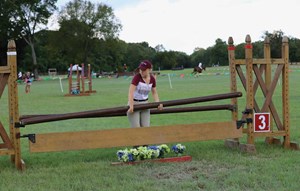 Texas A&M team rider Mona Fischer sets show-jumping fences while volunteering at a local horse trial. Mona is a German exchange student who joined the team this year. | © Manuel Flores
Texas A&M team rider Mona Fischer sets show-jumping fences while volunteering at a local horse trial. Mona is a German exchange student who joined the team this year. | © Manuel FloresUGA’s Emily Cox has had a similar experience as the Bulldogs’ president. As a club sport with the school, the team has access to advice from the administration but it’s clearly a student-run organization. “We run everything ourselves,” says Emily, who will graduate with a biological science degree in the spring. “We have a great group of officers and we organize everything: clinics, fundraisers and handling the treasurer responsibilities. It’s a lot of hard work, but it does pay off, especially being so successful, and it has a lot of rewards.”
Representing such a young team, Emily admits, “We were incredibly shocked at winning the championship. The school is really impressed!” And the victory has helped promote eventing within and beyond the school. “They may not have really known what eventing was, but we’ve been advertised on the USEA website and I think it helps them see us as legit sport.”
If the IEP fulfills its growth mission of adding more affiliate schools and creating more Intercollegiate Team Challenges, that phenomenon will repeat itself at campuses across the country for the good of collegiate eventers and the sport as a whole.
Calendar Challenges
Fitting collegiate eventing within the academic calendar presents some challenges. Otterbein, for example, has a strong team of competitors but they did not attend the championship because it fell three weeks after their school year ended in early May. Many riders had already left or graduated and the logistics of using the school’s coach and hauling rig are more complicated when school is not in session. Which is not to say they won’t figure out a way to compete in future championships, notes coach Kari Briggs.
Calendar concerns have stymied Sharyn Antiko’s desire to start an eventing team at Mount Holyoke College in South Hadley, Massachusetts, where it would join nationally successful IHSA hunt seat and IDA dressage teams. “Up here in New England, by the time the students get here and settled in, the eventing season is winding down,” says Sharyn, an eventer herself. “It gets back underway the last week of April and by May students are taking finals and leaving. I’m very active in the eventing scene and I would love to get one started here, but logistically it just doesn’t work.”
Save






